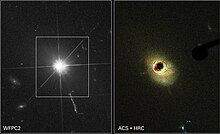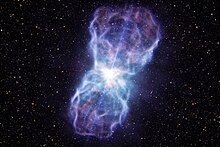quasar

Image of the quasar from the Hubble telescope

An artistically represented close-up (here from GB 1508 + 5714 ) ...

... and another drawing from a much greater distance (here SDSS J1106 + 1939 )
|

A quasar ( QSO for quasi-stellar object ) is the active core of a galaxy , which appears almost punctiform in the visible range of light (like a star) and emits very large amounts of energy in other wavelength ranges . The name Quasar was derived from the English quasi-stellar radio source , which can be translated as "star (s) like ..." or "star (s) like radio source ".
The radiation emission of a quasar comes from a rotating disk of luminous matter, the accretion disk , which surrounds a supermassive black hole .
Discovery and naming
Historically, the term referred to cosmic radio sources that could not be identified as radio galaxies in the 1950s , but instead appeared blue and "star-shaped" (i.e. not flat) in optical observations. In 1963, Maarten Schmidt determined through spectral analysis that the radio source 3C 273 is not a nearby star, but rather lies in the range of distant galaxies with a redshift of 0.158, i.e. not really a star, but only quasi -star-like. Later observations showed that the bright, star-like quasars are embedded in the cores of galaxies, but that they appear weak because of the great distance. Due to the strong redshift due to the expansion of the universe , quasars were recognized as very distant objects. This conclusion has been independently confirmed since the discovery of gravitational lenses . Quasars have now been discovered up to a redshift of 7.1.
With the discovery made in 2010 that the quasar SDSS J0013 + 1523, 1.6 billion light years away, acts as a gravitational lens for a galaxy 5.9 billion light years behind , there is a direct possibility of determining the mass of a quasar.
The term QSO (quasi-stellar object) includes not only the classic radio- loud quasars, but also radio-quiet objects with weak radio emissions, but otherwise similar properties. The term quasar is often used somewhat imprecisely for both classes.
Physical Properties
Since quasars appear relatively bright despite their great distance, they are among the most luminous objects in the universe. Only phenomena that light up brightly for a very short time ( supernova , gamma ray flash ) are possibly more energetic. Quasars are bright over large areas of electromagnetic radiation and have characteristic spectra with very broad emission lines that indicate rapidly moving gas. The luminous matter orbits the galactic core at high speed, the part of the matter that moves away from the observer experiences a redshift and the part that moves towards the observer experiences a blueshift. Overall, the spectral lines broaden as a result. Quasars can therefore be distinguished photometrically from a star by the very broad spectral lines.
Like the weaker Seyfert galaxies, quasars belong to the class of active galaxies . The separation based on luminosity is purely historical. According to current assumptions, there is a very massive black hole with a bulge in the center of all galaxies , which can comprise several million to billions of solar masses. Active galaxies differ from other galaxies in that this black hole increases in mass over time, as matter from the surrounding galaxy ( interstellar gas or ripped stars) is attracted by the gravitation of the black hole. This process of accumulating matter is called accretion in astronomy . Because of the angular momentum conservation in the infalling matter can fall they do not directly into the black hole, so that around it an accretion disk forms. This disk heats up due to friction , and parts of the matter lose angular momentum and can fall into the black hole. The emission of the heated accretion disk is what one observes as typical radiation of the quasar. It can achieve a luminosity similar to that of many billions of stars and thus emit more light than the entire surrounding host galaxy. The most luminous quasars reach up to 10 14 times the solar luminosity. However, the observation of the quasar Q0957 + 561 showed that it does not contain a black hole in the center, but can be better explained by an object of the MECO type .
If the accretion disk has a strong magnetic field, a small part of the flow of matter is torn into two parts and forced into paths along the field lines of the magnetic field. Subsequently, both currents are repelled perpendicular to the plane of the accretion disk (one on each side) at relativistic speed into the surrounding galaxy and the wider space. These jets can be observed in the radio wave length range.
Use as a reference system
Quasars are very bright, so they can be seen at great distances. At the same time, they are very far away, so that their movement in the sky is negligibly small and in fact no longer measurable. This property is used to build a reference system from the quasars. The International Celestial Reference Frame (ICRF) is a catalog of quasars and other objects, the positions of which have been measured with radio telescopes using VLBI to an accuracy of approx. 30 µas (micro- arcseconds ). This catalog can be used as a reference system for astronomical catalogs and for geodesy . As part of the publication of the Gaia mission, various versions of the Gaia Celestial Reference Frame were published, GCRF2 contains 556,869 quasars, GCRF3 is said to contain approximately 1.5 million quasars.
Unified model for classification
Yue Shen and Luis C. Ho found a model for the unified description of diverse quasar manifestations. Quasars emit different amounts of radiation, which occurs in very different spectral lines. Even with quasars of almost the same mass, one can find completely different emission lines in the spectrum. As unifying parameters, Shen and Ho suggested investigating how much and how quickly matter falls into the black hole and from which viewing direction the quasar is observed and its emission lines are obtained. The orientation of the axis of rotation of the black hole and thus the position of the accretion disk relative to the direction of view from the earth is important. Thanks to the Eddington limit described by Arthur Stanley Eddington in 1926 and the Eddington accretion rate, the ratio of the amount of incident matter to the radiated energy of the quasar, the mass of the matter-devouring object can be estimated and the mass of the quasar determined if the distance is known.
Blazar
The type of optically violent variable quasar / OVV quasar, the quasars with particularly rapid and strong variations in brightness, are counted together with the BL-Lac objects (very bright, star-like objects that consist of a very massive black hole that penetrates the matter brought down to a crash emits polarized radiation with strong brightness variations) to the group of so-called blazars. They are based on an angle between the direction of observation and the jet axis of at most a few degrees. With these objects, the jets approaching us at almost the speed of light can be “seen” even in the highest energetic areas of the spectrum through relativistic effects. The extremely fast outflow of matter jets leads to a negative pressure, known as relativistic inversion, in the core area of some quasars. The irregular accretion of new matter increases the variability. The EGRET ( GeV range) and COMPTEL (MeV range) experiments at the Compton Gamma Ray Observatory found ten objects that glow in both areas of the spectrum. A connection similar to that between quasars and blazars is suspected between quasars and radio galaxies in which the jet axis is almost perpendicular to the observation axis. These relationships are examples of “unified” models in which different types of active galaxy nuclei are explained by different directions of observation on similar objects.
Special discoveries
- In 1998 the particularly bright quasar APM 08279 + 5255 was discovered. It creates atypical triple images, contains one of the largest black holes and is orbited by a very large amount of water.
- In 2013 astronomers discovered the quasar SDSS J010013.02 + 280225.8 (shortened SDSS J0100 + 2802) from the catalog of the Sloan Digital Sky Survey (SDSS). Located about 12 billion light years from Earth, it contains an extremely massive black hole of 12.9 billion solar masses from a time when the universe was less than 900 million years old. These discoveries provide insights into the growth of black holes and galaxies in the young universe.
Philatelic
With the initial issue date 1 July 2019 which gave German Post AG in the series Astrophysics a postage stamp in the denomination of 110 euro cents called Black Hole / Quasar out. The design comes from the graphic designer Andrea Voß-Acker from Wuppertal.
See also
literature
- Joseph S. Miller: Astrophysics of active galaxies and quasi-stellar objects. University Science Books, Mill Valley CAL 1985, ISBN 0-935702-21-0 .
- Volker Beckmann, Chris R. Shrader: Active Galactic Nuclei (= Physics textbook ). Wiley-VCH , Weinheim 2012, ISBN 978-3-527-41078-1 .
- J. Chris Blades: QSO absorption lines - probing the universe. Cambridge University Press, Cambridge 1988, ISBN 0-521-34561-8 .
- Geoffrey Burbidge , Margaret Burbidge : Quasi-stellar objects. Freeman, San Francisco 1967.
Web links
- Robert Antonucci: No understanding of quasars. In: Spektrum.de. March 13, 2013. German translation, original title: Quasars still defy explanation. In: Nature 495. 2013, pp. 165-167.
- What is a quasar? from the alpha-Centauri television series(approx. 15 minutes). First broadcast on Mar 12. 2000.
- What is a blazar? from the alpha-Centauri television series(approx. 15 minutes). First broadcast on Apr 26, 2006.
- Rainer Kayser: Quasars: Where do the gas clouds go? . In: World of Physics. 5th October 2012.
- VizieR catalog.
Individual evidence
- ↑ Biggest Black Hole Blast Discovered. In: ESO.org. November 28, 2012, accessed June 11, 2020.
- ^ Artist's impression of the huge outflow ejected from the quasar SDSS J1106 + 1939. In: ESO.org. November 28, 2012, accessed June 11, 2020.
- ↑ SDSS J1106 + 1939. Entry in the English language Wikipedia.
- ^ Tilmann Althaus: Gravity. A quasar as a gravitational lens. In: Spektrum.de. July 26, 2010, accessed June 11, 2020.
- ↑ F. Courbin, SG Djorgovski, G. Meylan u. a .: Discovery of an Unusual Gravitational Lens. In: Astro.Caltech.edu. Retrieved June 11, 2020.
- ↑ David Shiga: Mysterious quasar casts doubt on black holes. Alternative quasar model. In: NewScientist.com. July 27, 2006, accessed June 11, 2020.
- ^ Yue Shen, Luis C. Ho: The diversity of quasars unified by accretion and orientation. In: Nature. Volume 513, pp. 210-213. September 10, 2014, accessed June 11, 2020.
- ↑ Harald Zaun: Mysterious gigantic beacons from cosmic prehistoric times. In: Heise.de. September 14, 2014, accessed June 11, 2020.
- ↑ Xue-Bing Wu, F. Wang, X. Fan, W. Yi, W. Zuo, Fuyan Bian et al: An ultraluminous quasar with a twelve-billion-solar-mass black hole at redshift 6.30. In: Nature. Volume 518, No. 7540, pp. 512-5, PMID 25719667 . February 25, 2015, accessed June 11, 2020.
- ↑ Bram Venemans: Black Holes. A giant in the young universe. In: Spektrum.de. February 25, 2015, accessed June 11, 2020.
- ↑ Davide Castelvecchi: Young black hole had monstrous growth spurt. Super-massive object found in early Universe tests theories of cosmic evolution. In: Nature.com. February 25, 2015, accessed June 11, 2020.
- ↑ Andrea Voss-Acker: Three galactic stamps from Wuppertal. In: Wuppertaler-Rundschau.de. July 2, 2019, accessed June 11, 2020.
